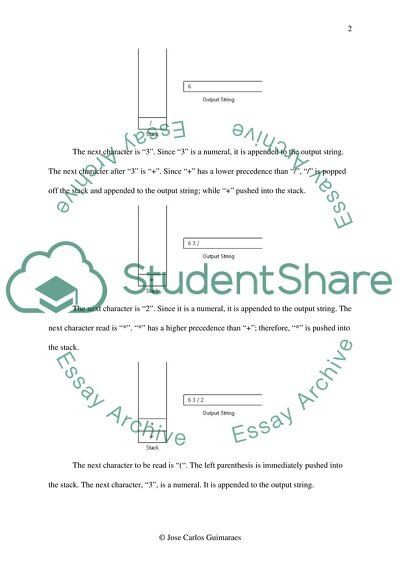
- Home
- Free Samples
- Premium Essays
- Editing Services
- Extra Tools
- Essay Writing Help
- About Us
- Studentshare
- Subjects
- Miscellaneous
- Data structures and algorithms n3
Data structures and algorithms n3 - Essay Example

- Subject: Miscellaneous
- Type: Essay
- Level: Undergraduate
- Pages: 4 (1000 words)
- Downloads: 0
- Author: lehnermikayla
Extract of sample "Data structures and algorithms n3"
Now the first character “6” is read. Since “6” is a numeral, it is added to the output string. The next character “/” is read. Since “/” is an operator, it is pushed into the stack. The next character is “3”. Since “3” is a numeral, it is appended to the output string. The next character after “3” is “+”. Since “+” has a lower precedence than “/”, “/” is popped off the stack and appended to the output string; while “+” pushed into the stack. The next character is “2”.
Since it is a numeral, it is appended to the output string. The next character read is “*”. “*” has a higher precedence than “+”; therefore, “*” is pushed into the stack. The next character is “+”. Since left parenthesis is present on top of the stack, “+” operator is pushed into the stack. The next character after “+” is “1”, which is a numeral. It is appended to the output string. The next character that is encountered is a “)”. Therefore, all the elements in the stack are popped off until a “(” encountered; and those elements are appended to the output string.
The left parenthesis is popped off, but it is not appended to the output string. In our case, the “+” operator is appended to the output string. The next character to be read is “–”. Since “–” has a lower precedence than both “*” and “+”, they are popped off the stack and appended to the output string; while “–” is pushed into the stack. The next character that is encountered is “8”. It is appended to the output string. Next character after “8” is “/”.
Since “/” has a higher precedence over “–”, it is pushed into the stack. The next character that is encountered is “2”. It is a numeral; therefore, it is appended to the output string. We reach the end of the sample expression, as there is no character after “2”. Therefore, all the elements in the stack are popped off
...Download file to see next pages Read MoreCHECK THESE SAMPLES OF Data structures and algorithms n3
Efficiency of Data Mining Algorithms in Identifying Outliers-Noise in a Large Biological Data Base
Algorithm Visualization
Temporally-Ordered Routing Algorithm
Data Structures and Algorithm Applications in Social Media
String Processing Structures and Algorithms
Identifying Outliers in a Large Biological Data Base
Educational Timetabling Algorithms and Data Structure
Using Rank Based KNN Queries Processing to Reduce Location Uncertainty in Wireless Sensor Networks

- TERMS & CONDITIONS
- PRIVACY POLICY
- COOKIES POLICY